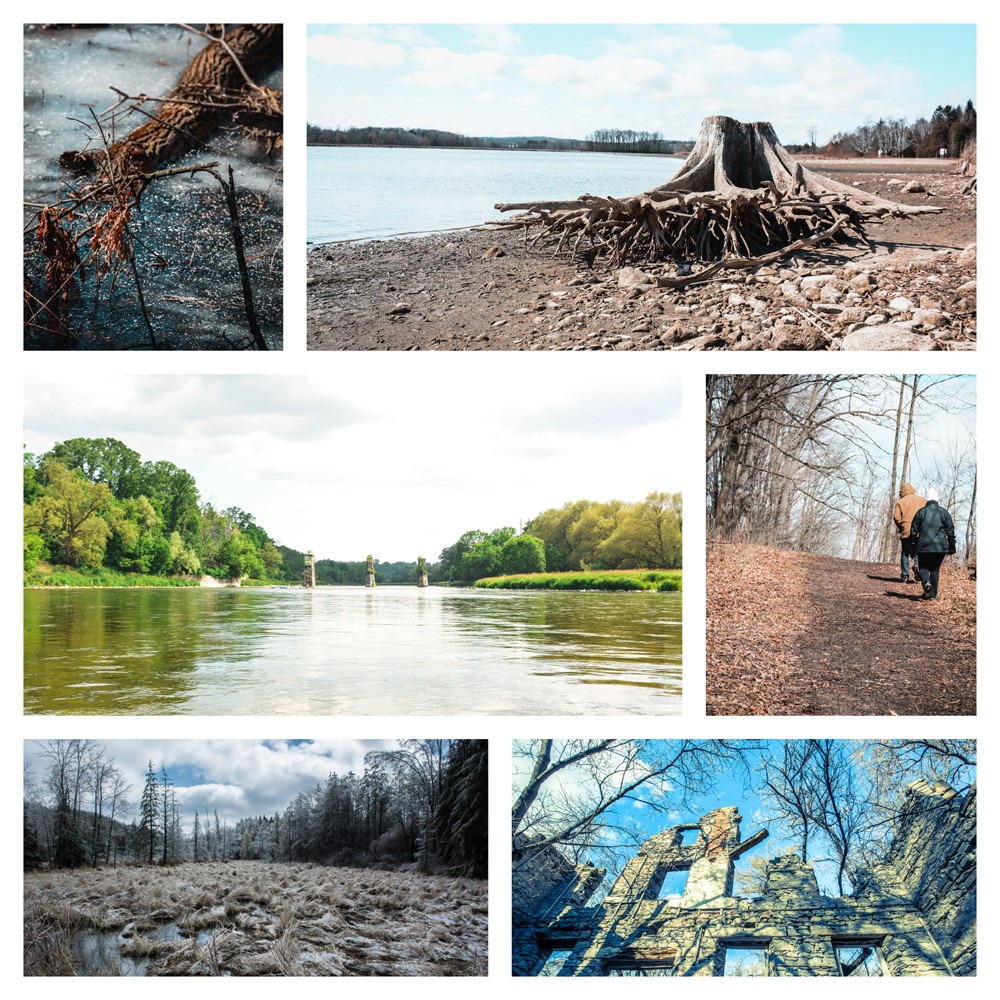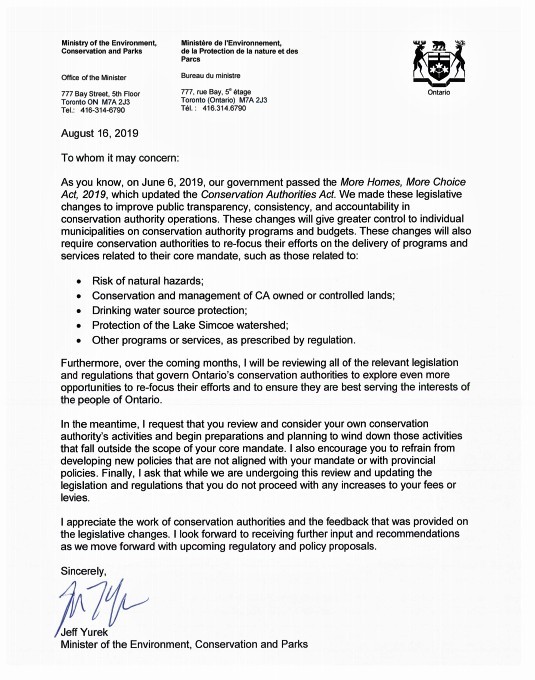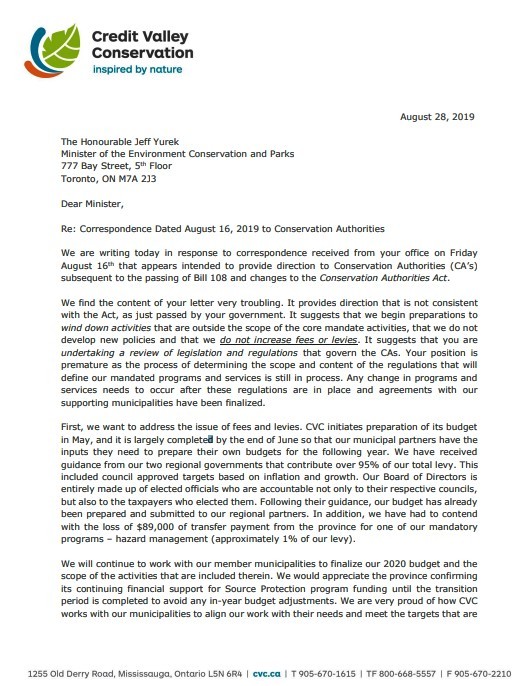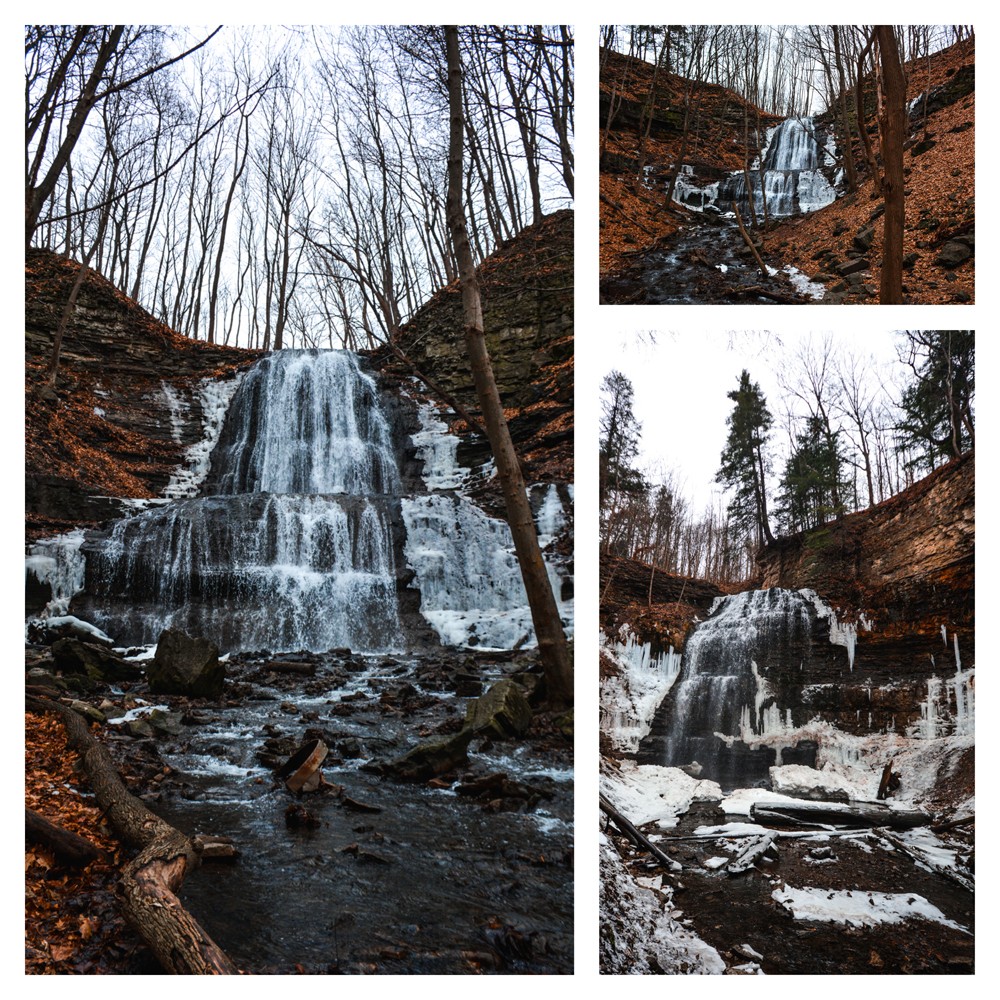
‘People should be worried’: Province moves to hobble conservation agencies, hand power to developers
The Credit Valley Trail, a project more than 50 years in the making, envisions a 100-kilometre route for hikers to traverse through the lush watershed, from the sparkling headwaters right down to the mouth of Lake Ontario.
Surrounded by dense canopies of trees and some of the most ecologically sensitive lands within the giant basin that drains to the great lake, nature lovers can escape the chaos of city life.
The vision behind the trail is to showcase the biodiversity that has survived alongside some of the most dense urban environments in Canada. The approximately 90-kilometre Credit River and its tributaries carry the lifeblood of a watershed that expands nearly 95,000 hectares from Port Credit and Lake Ontario in the south, to Orangeville in the north. It is bordered by some of Ontario’s most stunning, and popular natural features, including the Greenbelt, the Lake Ontario shoreline, the Oak Ridges Moraine and the Niagara Escarpment.

TORONTO REGION CONSERVATION AUTHORITY
“Expanding growth and intensification in Ontario through increasing housing supply and creating jobs must be commensurate with managing natural hazards and conserving natural resources.”
—Jennifer Innis, TRCA Chair, John MacKenzie, TRCA CEO
The Credit Valley Trail project is being led by the Credit Valley Conservation Authority (CVC), along with many partners, and looks to not only link these natural features along a single thread of gravel and boardwalk, but connect the residents of the surrounding area to the watershed their communities rely upon.
Being stuck in traffic on Highway 401 may feel like the furthest place from the natural world, but the motorways, the downtown streets of Mississauga or Brampton, the labyrinth of suburban roads, are all part of the watershed, and what happens in the cities is irrevocably linked to the natural environment.
Like the force of tectonic plates erupting into one another, the collision of the urban and the natural is never smooth.
For the last five decades, the work of managing this tenuous relationship between the urban and natural, and minimizing the damage to ecosystems that everything relies on, has fallen to Ontario’s 36 conservation authorities.
These organizations have been responsible for reviewing development applications for potential environmental impacts as well as any safety concerns — like flooding or erosion potential — and monitoring waterways for flood risks. The CAs also provide invaluable education opportunities for residents to learn about the watersheds, ecosystems and wildlife we share this land with.
During heavy rainfalls, when a warning is issued, it will originate from data and alerting systems set up by conservation authorities so that citizens can get themselves out of harm’s way before the high water arrives. The CAs also work directly with municipalities on a range of projects, from planning for flood mitigation in urban areas to helping detect illegal contamination of our waterways when residents and businesses dump harmful toxins that seep into creeks, rivers and lakes. Protecting wildlife from harm is another crucial function.
Much of their work could soon be curtailed.
The PC government under Premier Doug Ford is looking to change the mandate of conservation authorities by stripping power away from those tasked with protecting our land for future generations, and handing it to politicians and developers, putting the people and the animals who call these watersheds home, at immediate risk.

CREDIT VALLEY CONSERVATION AUTHORITY
“The long-term consequences will be very hard to undo, and we have worked very hard for many years at the Credit Valley Conservation to do what is right for the environment and try to strike a balance between good development and protecting our watershed.”
— Karen Ras, CVC Chair
Through its Bill 229 - Protect, Support and Recover from COVID-19 Act, the PC government is proposing a number of amendments to current legislation. Schedule 6 takes aim at the environment and will change the way conservation authorities are involved in the development process.
The proposed Schedule 6 looks to create a veto power for the Minister of Natural Resources and Forestry to make decisions on development applications, regardless of what the conservation authority and its team of experienced scientists say about the risks, or the development’s impact on the surrounding environment.
In the past, when such an application was forced through by a municipality, conservation authorities have had the ability to appeal decisions to the Local Planning Appeals Tribunal (LPAT) and previously the Ontario municipal board, if that development contravened environmental protections or could put further pressure on strained species or ecosystems. The PCs are trying to strip that power.
Despite trying to push the new legislation through under the cover of a COVID-19-related recovery Bill, the changes were not missed by scores of environmental advocates and conservation authorities in Ontario, many of whom have spoken out about the impact of the PCs' proposed move.
“I’m really trying to understand a rationale, and none is coming to me when I look at a lot of these changes,” says Karen Ras, chair of the CVC board of directors and Mississauga councillor.
“It’s a huge concern for protecting the environment, but it’s also a huge concern for people and property,” says Jennifer Innis, chair of the Toronto Region Conservation Authority (TRCA) and Caledon councillor.
Following the trail of PC decision making since Premier Ford’s election in 2018, it is easy to see the motivation behind Schedule 6. Premier Ford’s cozy relationship with the development community has been evident in the PCs' previous attempts to dismantle environmental regulations — see Bill 66 and the PCs' increasing use of Ministerial Zoning Orders — to favour a powerful development lobby. Not to mention Premier Ford’s promise to developers, caught on hidden camera ahead of the 2018 election, that he would open up the Greenbelt, a crucial piece of protected Ontario green space, for development.
“They’re pandering to developers and rural land owners,” Ras says. “It’s not even veiled.”


CENTRAL LAKE ONTARIO CONSERVATION AUTHORITY
“This bill is more than its name suggests. The Bill includes Schedule 6 which proposes changes to the Conservation Authorities Act and Planning Act that will reduce our ability to protect sensitive natural areas, and keep people and property safe from natural hazards.”
— Chris Darling, CLOCA CAO
Leaders at the CVC note the changes proposed by the PCs replace scientific decision making with politics, something that could have dangerous implications for the GTA’s big cities.
“Public safety is job one for us, and that is what is at risk with what they have put in this bill,” says Deborah Martin-Downs, the chief administrative officer for the CVC. “I think that just speaks to a lack of understanding or value that they place in the conservation authorities which is very unfortunate, because whether you like us protecting trees and biodiversity and other things, or the conservation areas that we provide, leave that aside, conservation authorities have had a tremendous success and responsibility in keeping property and people safe since 1956.”
It’s a role that is growing increasingly significant as the world’s climate continues to change. Significant weather events are becoming more common, and the monitoring of rainfall and water levels in local rivers and streams is a 24/7 job for the CVC, something that Martin-Downs says has “changed dramatically” over the last 15 years. The CVC has about 30 monitoring stations throughout the watershed that track not only water levels, but water quality and stream turbidity as well, which can inform valuable, long-term research about the health of the ecosystem.
Data from monitoring stations across the Credit Valley watershed help the CVC make decisions about flood risk and inform long-term research.
The jurisdiction of two conservation authorities — the CVC and the TRCA — overlap the Region of Peel, with the TRCA’s coverage encompassing Brampton and CVC covering Mississauga. Last year, the CVC reviewed 405 development applications, the TRCA handled 720, including over 1,200 permit requests. While conservation authorities are tasked with ensuring the urban growth within their jurisdiction does not have a disproportionate impact on the land, water and animal species in their watershed, these application reviews are more focused on ensuring a new home, a school, or the dream of a small business owner looking to open up shop, is not done on land that would eventually be destroyed or damaged by flooding or erosion.
This isn't to say that mitigating environmental impacts is not a crucial role for these organizations. Stemming the tide of environmental degradation in Ontario is more important now than it has ever been. As a result of Ontario’s booming growth, the majority of the province’s wetlands — 68 percent — were destroyed before the early 1980s. A further 4 percent has been lost since then, the majority in major urban centres. The continued destruction of these valuable natural assets has significant implications on fish and bird life. Approximately 80 species of fish rely on the mineral rich coastal wetlands at some stage in their life cycle, a further 50 species are solely dependent on these coastal ecosystems their entire life. Similarly, numerous bird species rely on these coastal marshes as migratory stopovers to rest their wings, and as breeding grounds.

SAUGEEN VALLEY CONSERVATION AUTHORITY
“This is a fundamental time in the history of our Province. The changes to the Conservation Authorities Act will impact the future of environmental protection in the Province of Ontario and is likely to have unintended consequences."
— Dan Gieruszak, SVCA Chair
It’s clear that the PC government will not be convinced to change course on Schedule 6 based on the potential number of wildlife lost. This is the same government that, with very little scientific reasoning, opened hunting season on the cormorant in September of this year, allowing hunters to shoot up to 15 of these birds every day. The cull has significant implications, not only because the cormorant closely resembles other shorebirds, like the Common Loon (found on the Canadian dollar coin), which hunters will almost certainly kill by mistake, but the cull is not supported by naturalists who claim the PC government is relying too much on information from the sport fishing industry and coastal property owners who are menaced by the birds, which can destroy areas where they nest.
The reversal of Schedule 6 does not only have positive impacts for the environment, it has the potential to save municipalities money, something that should turn bureaucratic heads with finance officials sweating through local budgets trying to balance the impact of the pandemic with future needs. Wetlands, which conservation authorities are bound to protect, provide significant value for municipalities — the irony is that many of them were paved over decades ago for being seen as useless. For example, after the City of Toronto previously paved over all of the coastal wetlands at the mouth of the Don River, it is now spending millions of dollars to restore its valuable functions. It’s now known these wetlands provide invaluable flood mitigation, water filtration, carbon storage, provide vital wildlife habitat and recreation opportunities for local residents — which can have significant benefits for mental health, thereby reducing reliance on the healthcare system.

GRAND RIVER CONSERVATION AUTHORITY
“This legislation introduces a number of changes that could remove or significantly hinder the GRCA’s role to manage watershed natural resources and ensure people and property are safe from natural hazards.”
— Helen Jowett, GRCA Chair
This is the knowledge that governments are meant to receive from its expert panels — like the Greenbelt Council — or from the conservation authorities themselves, but that’s clearly not happening.
Martin-Downs says “they are not asking us any questions, they are just doing,” and last month Linda Pim, a member of the Greenbelt Council alongside Martin-Downs, resigned after the PC government and Municipal Affairs Minister Steve Clark issued an MZO, a heavy-handed and seldom used provincial override of municipal planning authority (despite the Council’s objections) for a controversial development in Pickering within Duffins Creek, a provincially significant wetland complex. Pim states the government’s decision “flagrantly contravenes” its own environmental policies.
“I have simply had enough,” Pim wrote to Minister Clark. “I have lost confidence in your government’s commitment to honour and meet Ontario’s long-standing requirements to protect our precious natural heritage from development.”
This is not the first time Minister Clark has issued an MZO for a controversial development during the current term. He has issued more MZOs in a little over a year than the entire 15 years of Liberal rule that preceded him. Nearly half of the 33 MZOs issued in 2020 were for residential developments, and four issued in a single day in April led to the destruction of three small wetlands, claiming the developments are essential to help the economy recover from COVID-19.
“To have the experts who are tasked with advising the government and then their own experts are saying this is a farce, you’re not listening to us at all, it’s very disappointing to lose expert voices,” says Oshawa MPP Jennifer French, who has been extremely critical of the government’s use of MZOs and the decisions around Duffins Creek. “It’s in keeping with what we know about this premier and this government, that money talks, but it should not be speaking for the environment.”
Science is being removed from the equation, critics say. Schedule 6 allows applicants to appeal to the Minister directly, should the conservation authority make a decision they are not happy with. Not only will this likely create a deluge of appeals that could overwhelm the ministry, it sets a dangerous precedent by allowing a minister, and politicians with zero scientific background, to make decisions about sensitive ecosystems. Judging by the free-wheeling use of MZOs, Martin Downs is sure the new veto power will also be used frequently to ram through new development applications.
“This government has not given us the confidence that it would only be rarely used, it has given us the signal that we intend to use this and we intend to ensure that if a developer wants to do something, or even a municipality wants to do something, we’re going to make it happen for them, and that may not be in the public interest,” she says. “The timing of these modifications relative to the use of the MZOs is very suspect in my mind.”
The encroachment on the authority of the conservation agencies began almost as soon as Ford and his PC majority government began wielding its pro-developer stick when assuming power in 2018, after he was caught on a secret video during the campaign promising a room filled with developers that, if elected, he would open up a big chunk of the protected Greenbelt for them.
Last year, an open letter (see below) was sent to the province’s conservation authorities, including Credit Valley Conservation (CVC) in Peel Region. Environment Minister Jeff Yurek basically told them to stop doing what they’ve been so successfully doing for the past 60 years: saving us from ourselves.

Yurek said things have to change, especially now that Bill 108 (More Homes, More Choice) had passed – the Act that has opened up a wide avenue so developers could build more single-family homes – just like it did during the last time a PC government (Mike Harris-Ernie Eves) was in power in the late '90s and early 2000s.
Wrote Yurek: “We will review your activities and wind down those activities that fall outside the scope of your core mandate.”
He also warned the conservation authorities not to develop new policies or increase fees or levies. His short but blunt letter landed with a decided thud in the office of Ras.
It’s clear from her response (see below), she has found the PCs' efforts “very troubling.” She said, at the time, that Yurek’s direction was inconsistent with Bill 108, and even premature since much of the policy design to support the legislation was still in progress. She also questioned his comment about fees and levies since they had already been worked out with the local municipalities, which had set their budgets when the alarming letter was sent in August of last year. She thought Yurek was “vague on details,” and conservation authority staffers weren’t consulted and no policy drafts were circulated.

Ras bristled at his remarks directed against CAs, and wrote back to the minister, “we deliver programs and services that have value.”
Ras concluded by challenging the minister to engage in “meaningful” consultations.
For the CVC, the watershed it is tasked with caring for spans the land of 10 municipalities. In order to balance the needs of the watershed with those of the local towns and cities, the board of directors at the CVC is responsible for bringing these interests to the same table and making decisions about what is best for everyone who calls the watershed home.
Inexplicably, Schedule 6 looks to change this by ensuring board members act on behalf of the municipality they represent, and not in the interest of the conservation authority. A quick look at a map of the CVC, or any of Ontario’s 36 conservation authorities, many of which involve multiple municipal partners, shows how that change will be problematic.

GREY SAUBLE CONSERVATION AUTHORITY
“The changes being proposed by the Province will effectively undo decades of thoughtful planning to keep our communities safe.”
— Tim Lanthier, GSCA CAO
The CVC includes Brampton, Mississauga and the upper tier Region of Peel, among others. If the representatives from these municipalities begin to think only about Brampton, or only about what is best for Mississauga, it will either create a patchwork of protections that is completely ineffective for a watershed that spreads across artificial municipal boundaries, or it will result in gridlock around the board table with competing interests. Under these scenarios, it is environmental protection and the vital programming of the conservation authority that is hampered.
“One of the valuable things about conservation authorities is that we try to provide those services equally through the watershed,” Martin-Downs says. “We have monitoring stations throughout the watershed, not just where Peel will pay for them or where Halton will pay for them.”
The proposed changes in Schedule 6 have created an upheaval within the conservation industry. Conservation Ontario, the organization that represents the province’s 36 conservation authorities is calling for a “sober second thought”; Ontario Nature has demanded a full reversal of Schedule 6 which it says “severely curtails” the work of conservation authorities; and the Canadian Environmental Law Association (CELA), noted in a preliminary analysis that most of the amendments in Schedule 6 are “regressive in nature and are completely contradictory to fulfilling both the purpose of the Conservation Authorities Act and the desire to set the course for more climate resilient communities in the future.”

HAMILTON CONSERVATION AUTHORITY
"The legislative changes appear to be an excessive intervention in local matters in an area where the province makes little financial contribution. In the case of HCA, the province contributes just two per cent of the annual revenues for the operating budget."
— Lloyd Ferguson, HCA Chair
For the Credit Valley Trail, a milestone moment was darkened in the shadow of the PCs' introduction of Schedule 6. On November 3, the Credit Valley Trail hammered its first stake in the ground at the Upper Credit Conservation Authority in Alton. The wayfinding point is the first physical indicator of the trail, bringing it out of the realm of idea and into the real world. Approximately 32 kilometres of existing trails have already been set aside to eventually form part of the bigger picture, but with the PCs' attempts to dismantle Ontario’s environmental protections, 50 years of trying to make the trail a reality could all be for naught
"I think people should be worried,” Ras says. “Watersheds and our natural environment expand well beyond our immediate living area, the long-term consequences will be very hard to undo, and we have worked very hard for many years at the Credit Valley Conservation to do what is right for the environment and try to strike a balance between good development and protecting our watershed.”
Email: [email protected]
Twitter: @JoeljWittnebel
COVID-19 is impacting all Canadians. At a time when vital public information is needed by everyone, The Pointer has taken down our paywall on all stories relating to the pandemic and those of public interest to ensure every resident of Brampton and Mississauga has access to the facts. For those who are able, we encourage you to consider a subscription. This will help us report on important public interest issues the community needs to know about now more than ever. You can register for a 30-day free trial HERE. Thereafter, The Pointer will charge $10 a month and you can cancel any time right on the website. Thank you.
Submit a correction about this story


